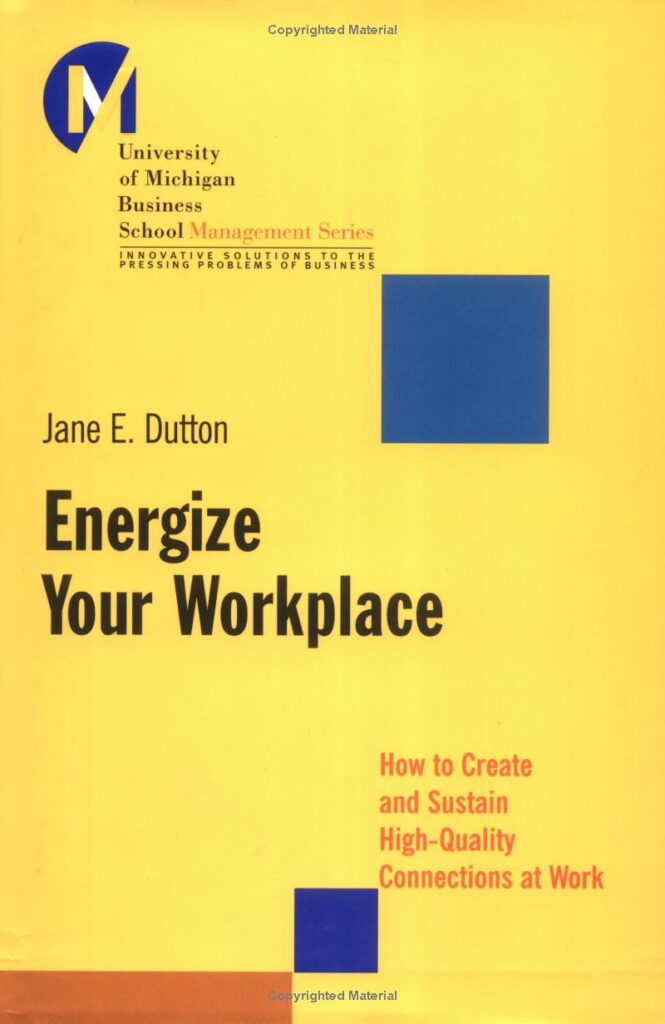
1 Line Summary
“Energize Your Workplace” shows how high-quality connections at work can boost employee energy, resilience, and productivity.
What Will You Learn
You’ll learn how to:
- identify and build high-quality connections at work,
- turn negative connections into positive ones,
- create a positive workplace culture,
- boost energy, resilience and productivity.
Best Quotations from the Book
- “High-quality connections are those that are characterized by mutual respect, trust and caring.”
- “Corrosive connections are those that are characterized by disrespect, distrust and indifference.”
- “High-quality connections generate energy while corrosive connections drain it.”
- “The more high-quality connections you have, the more energized and productive you will be.”
- “You can’t control who you connect with, but you can control how you connect with them.”
- “The human brain is wired for connection.”
Book Summary
What are High Quality Connections
High Quality Connections (HQCs) are defined as interactions that generate positive emotions, enhance vitality, and foster mutual respect and trust. HQCs are vital for creating and sustaining a healthy and productive work environment.
Creating and sustaining high-quality connections at work is an essential endeavor for fostering a productive and engaged workforce. Drawing from the insightful contents of the book “Energize Your Workplace: How to Create and Sustain High-Quality Connections at Work,” we can distill key strategies and principles that executives can implement to achieve this goal.
How to Create Energy Through High-Quality Connections at Workplace
- Foster Open Communication Channels:
Encourage an environment where open communication is valued. Implement regular team meetings, one-on-one discussions, and feedback sessions.
By facilitating transparent communication, you create a space where employees feel heard and understood, generating positive energy and enthusiasm.
- Empower Employee Autonomy:
When individuals have a sense of ownership over their work, they feel empowered and motivated. Executives should delegate responsibilities and trust employees to take ownership of their tasks.
This autonomy not only increases engagement but also generates a sense of energy and purpose in their contributions.
- Recognize and Appreciate Contributions:
Regularly acknowledge and appreciate the efforts of your team members. Implement formal recognition programs and provide specific feedback for a job well done.
Recognition generates positive energy by reinforcing the idea that each contribution matters and makes a difference.
- Promote Collaborative Opportunities:
Create avenues for collaboration and teamwork. Encourage cross-functional projects and initiatives that require employees to work together towards a common goal.
When employees work together and leverage each other’s strengths, they feel energized by the collective synergy.
How to Create Respectful Engagement at Workplace
- Promote Inclusive Communication:
Encourage inclusive communication practices that value diverse viewpoints.
This involves actively seeking input from all team members and ensuring that discussions are conducted with openness and respect for differing perspectives.
- Cultivate Empathy and Active Listening:
Empathy is a cornerstone of respectful engagement. Executives should lead by example, showing genuine concern for employees’ feelings and well-being.
By practicing empathy and active listening, leaders demonstrate respect and foster deeper connections.
- Set Clear Expectations and Boundaries:
Clearly define expectations, roles, and responsibilities for team members. When individuals understand their tasks and boundaries, conflicts are minimized, and respect prevails.
Executives should ensure that team members are aware of their contributions’ impact on the overall goals and encourage them to communicate any challenges they face.
- Address Conflict Constructively:
Conflict is inevitable, but how it’s managed determines the level of respectful engagement. Executives must facilitate constructive conflict resolution by creating a safe space for open discussions.
Leaders should provide guidance on resolving conflicts through active problem-solving and encourage compromise, ensuring that differences are handled respectfully.
Task Enabling at Workplace
- Provide Clear Role Definitions:
Clearly define roles and responsibilities for each team member. Executives should ensure that employees understand their specific tasks and how they contribute to the overall goals.
This clarity prevents confusion and empowers individuals to take ownership of their responsibilities, leading to a sense of task ownership and accomplishment.
- Offer Learning and Development Opportunities:
Executives must provide opportunities for skill development and training, enabling employees to enhance their abilities and contribute more effectively.
By investing in their growth, leaders signal their commitment to employees’ success, fostering a sense of task enabling and professional advancement.
- Foster Supportive Feedback Culture:
Create an environment where constructive feedback is encouraged. Executives should provide regular feedback that highlights strengths and areas for improvement.
Constructive feedback guides employees in refining their tasks, making them feel supported and empowered to excel in their roles.
- Delegate Decision-Making Authority:
Trust employees with decision-making authority related to their tasks. Executives should delegate decision-making responsibly, giving team members the autonomy to make choices within their domains.
This delegation of authority not only speeds up decision-making but also empowers employees to take initiative and contribute meaningfully.
Healthy Trusting at Workplace
- Lead by Example with Transparency:
Executives must lead the way in demonstrating transparency in their actions and decisions. When leaders are open and honest about organizational matters, it sets a precedent for trust.
Sharing information, addressing concerns, and explaining the rationale behind decisions build credibility and demonstrate that trust is a two-way street.
- Delegate Responsibility and Autonomy:
Trust is nurtured when employees are given the autonomy to make decisions within their roles. Executives should delegate responsibilities, allowing individuals to take ownership of their tasks.
This empowerment not only demonstrates trust in employees’ capabilities but also encourages them to contribute confidently.
- Encourage Risk-Taking and Learning from Mistakes:
Executives can foster an environment where calculated risk-taking is encouraged. When employees are willing take risks, they are more likely to innovate and explore new ideas.
Executives should demonstrate that mistakes are seen as opportunities for growth and learning, rather than as reasons for blame.
- Promote Confidentiality and Respect for Privacy:
Building trust also involves respecting employees’ privacy and confidentiality. Executives should ensure that sensitive information is handled responsibly. This includes safeguarding personal information and maintaining confidentiality in discussions.
When employees feel that their privacy is respected, they are more likely to trust their leaders and colleagues.
How to Deal With Corrosive Connections at Workplace
- Identify and Acknowledge Corrosive Behavior:
The first step in addressing corrosive connections is recognizing and acknowledging their presence. Executives should be attentive to signs of negative behavior like hostility, gossip or undermining actions.
By promptly identifying these behaviors, leaders can prevent them from escalating and negatively impacting the workplace environment.
- Open Dialogue and Address Concerns:
Engage in open dialogue with the individuals involved in the corrosive connections. Executives should provide a safe space for discussing concerns and conflicts.
Facilitate constructive conversations where individuals can express their perspectives and feelings. Addressing the issues directly can often lead to understanding and resolution.
- Provide Constructive Feedback and Coaching:
Executives must offer constructive feedback to individuals displaying corrosive behavior, provide specific examples of the behavior and its impact on the team and organization and offer coaching and guidance on how to improve interactions and contribute positively.
By offering support, leaders can help individuals change their behavior and contribute to a healthier work environment.
- Implement Mediation and Conflict Resolution:
The book emphasizes that executives should implement conflict resolution strategies to facilitate productive discussions and find common ground.
Mediation can help individuals understand each other’s perspectives and work toward a resolution that rebuilds trust and collaboration.
Building High-Quality Connections in Your Organization
- Set a Vision and Strategy for Connection-Building:
Define a clear vision for fostering high-quality connections throughout the organization.
Develop a strategic plan that outlines specific initiatives, goals and timelines to guide the connection-building process.
- Implement Communication Strategies:
Implement communication strategies that encourage transparent sharing of information, ideas, and feedback.
Executives should foster open channels for communication, e.g. regular team meetings, town halls and digital platforms, to ensure that employees are well-informed and engaged.
- Recognize and Reward Collaborative Efforts:
The book highlights that executives should acknowledge and reward individuals and teams that actively contribute to building high-quality connections.
Publicly recognizing collaboration reinforces its importance and encourages others to follow suit, creating a culture where teamwork and connections are valued.
- Share Success Stories and Best Practices:
Executives should create platforms to share success stories and best practices related to building connections. Highlight instances where strong connections led to positive outcomes and showcase individuals who exemplify connection-building behaviors. Sharing these stories inspires others and provides practical examples to emulate.
Want to create a more energized and productive workplace? Read “Energize Your Workplace” and learn how to build high-quality connections with your colleagues.
Click to know “12 Rules for Life”, “The Six Pillars of Self Esteem”, “14 Essential Leadership Traits“, “The 5 Levels of Leadership“, “The Five Dysfunctions of a Team“ and “The Role of Self Awareness in Leadership“


Pingback: “The Compound Effect” by Darren Hardy -